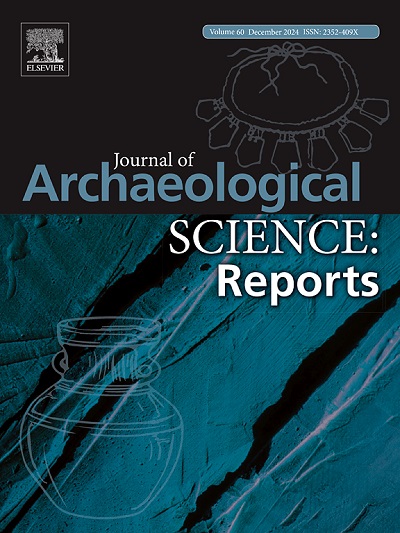伊朗伊拉姆省西尔万遗址文化物质地球化学物源研究
IF 1.5
2区 历史学
0 ARCHAEOLOGY
引用次数: 0
摘要
本研究旨在调查伊朗伊拉姆省西尔万国家遗产地的历史背景,并对6个沉积物样本和15个无釉陶器碎片进行实验室研究。利用光激发光(OSL)测年法确定了沉积物层的年龄,并估算了该遗址的沉降时间。分析结果表明,T.T.203.13沉积层年龄约为4000 ± 700 年,可追溯到埃兰族历史时期。此外,T.T.203.11层将该遗址的历史追溯到帕提亚和早期萨珊时期,估计约为1700 ± 200 年。因此,与考古学家和历史学家的观点相反,这个地区比萨珊王朝晚期和伊斯兰教早期的地区更古老。除了OSL定年外,还使用XRF和XRD方法对陶器和沉积物样品进行了地球化学和矿物学分析。这些分析的结果表明,所研究的陶器样品的化学成分彼此非常相似,并且与所分析的沉积层之一(T.T.203.11)具有显著的相似性。这一地球化学相似性强化了利用当地土壤资源制造历史塞尔万陶器的假设,表明这些陶器可能与T.T.203.11沉积层属于同一历史时期,可能对应于早期萨珊时期。这项研究利用多学科方法和实验室方法,以互补的方式,在调查塞尔万历史遗址的年龄和确定陶器原料的来源方面迈出了重要的一步。在确认该遗址的古代和历史重要性的同时,它也可以作为随后在西尔万考古和文化材料来源领域研究的基础。本文章由计算机程序翻译,如有差异,请以英文原文为准。
Geochemical provenance studies of cultural materials from Sirvan historical Site, Ilam Province, Iran
This study aimed to investigate the historical background of the National Heritage Site of Sirvan in Ilam Province, Iran, and to conduct laboratory studies on six sediment samples and 15 unglazed potsherds. The optically stimulated luminescence (OSL) dating method was used to determine the age of the sediment layers and estimate the time of settlement at this site. The results of this analysis show that the age of the sediment layer T.T.203.13 was approximately 4000 ± 700 years, dating back to the Elamite historical period. Additionally, layer T.T.203.11, which dates the history of this site back to the Parthian and early Sasanian periods, is estimated to be about 1,700 ± 200 years. Therefore, contrary to the opinions of archaeologists and historians, this area is older than those of the late Sasanian and early Islamic periods. In addition to OSL dating, geochemical and mineralogical analyses of the pottery and sediment samples were performed using XRF and XRD methods. The results of these analyses showed that the chemical compositions of the studied pottery samples were significantly similar to each other and exhibited a notable resemblance to one of the analyzed sediment layers (T.T.203.11). This geochemical similarity strengthens the hypothesis of using local soil resources in the manufacture of historical Sirvan pottery and indicates that these potteries probably belong to the same historical period as sediment layer T.T.203.11 and likely correspond to the early Sasanian period. This research, utilizing a multidisciplinary approach and laboratory methods in a complementary manner, has taken a significant step toward investigating the age and identifying the origins of pottery raw materials at the Sirvan historical site. While confirming the antiquity and historical importance of this site, it can also serve as a basis for subsequent studies in the field of archaeometry and provenance of cultural materials in Sirvan.
求助全文
通过发布文献求助,成功后即可免费获取论文全文。
去求助
来源期刊

Journal of Archaeological Science-Reports
ARCHAEOLOGY-
CiteScore
3.10
自引率
12.50%
发文量
405
期刊介绍:
Journal of Archaeological Science: Reports is aimed at archaeologists and scientists engaged with the application of scientific techniques and methodologies to all areas of archaeology. The journal focuses on the results of the application of scientific methods to archaeological problems and debates. It will provide a forum for reviews and scientific debate of issues in scientific archaeology and their impact in the wider subject. Journal of Archaeological Science: Reports will publish papers of excellent archaeological science, with regional or wider interest. This will include case studies, reviews and short papers where an established scientific technique sheds light on archaeological questions and debates.
 求助内容:
求助内容: 应助结果提醒方式:
应助结果提醒方式:


